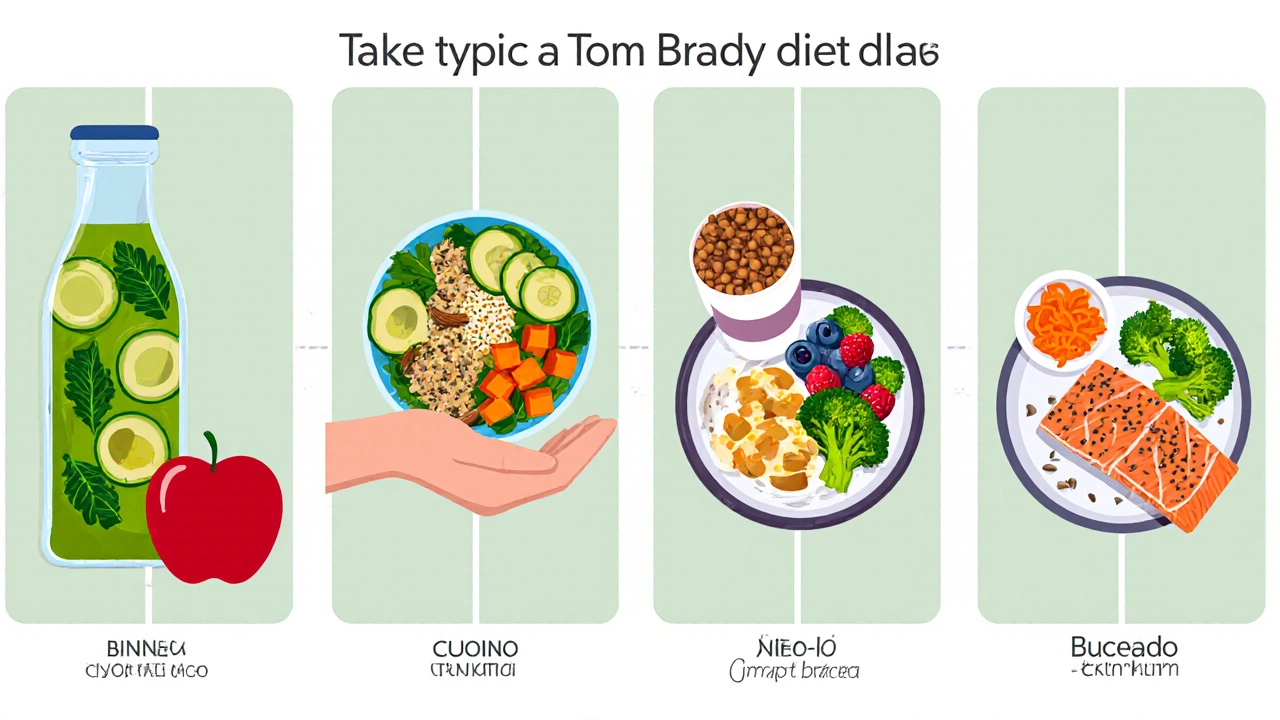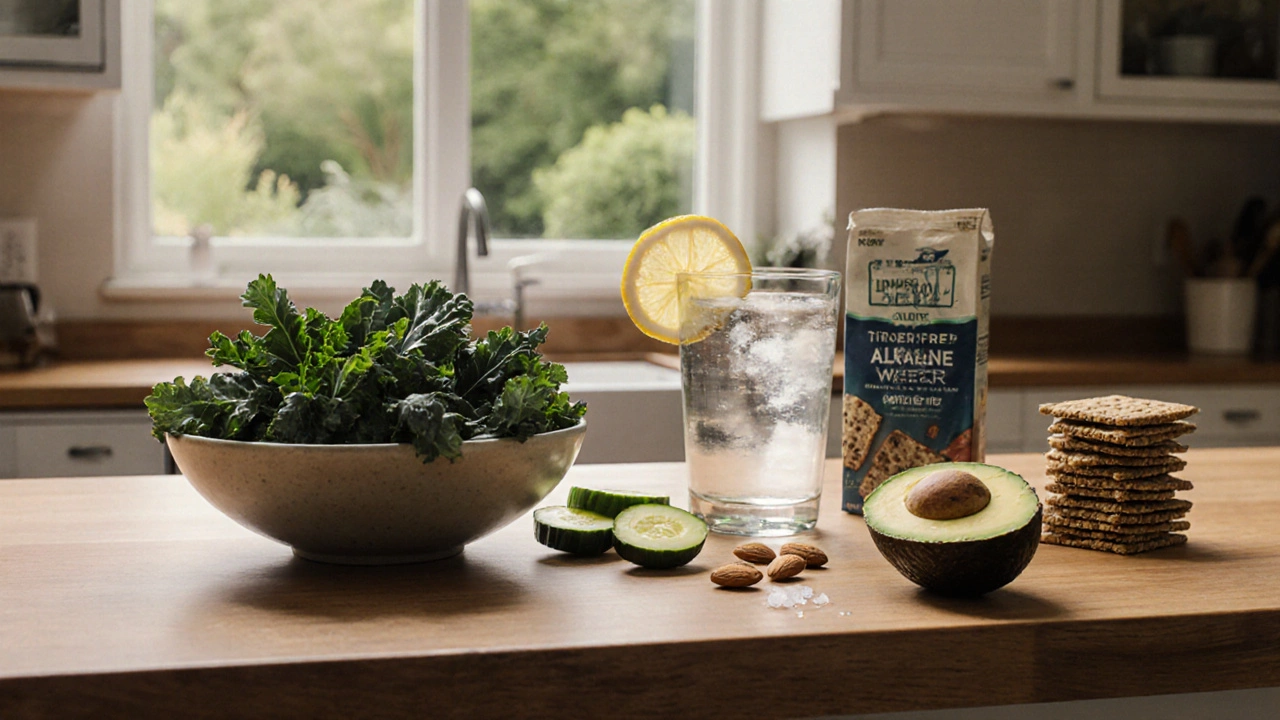Tom Brady Diet Calculator & Meal Planner
Personalize Your Plan
How It Works
This calculator determines your personalized daily calorie needs based on the TB12 diet principles. It considers your current metrics, activity level, and weight goals to generate a plan within the recommended 1,800-2,200 kcal range.
Your Personalized Plan
Before 7 PM
Sample Meal Plan
Warm water + lemon
Almonds + apple
Quinoa bowl with veggies
Coconut yogurt with berries
Salmon + broccoli + kimchi
Ever wondered why the NFL legend can keep playing at 47? The secret isn’t just his training - it’s the Tom Brady diet. Below we unpack the whole approach, the foods that make it work, and how you can tailor it for weight‑loss clinic clients.
What the Tom Brady diet actually is
Tom Brady diet is a high‑alkaline, mostly plant‑based eating plan popularized by the quarterback’s TB12 method. It blends principles from the Alkaline diet, focuses on whole foods, eliminates most processed sugar, and limits night‑time eating. The idea is to keep the body’s pH slightly alkaline, reduce inflammation, and fuel recovery.
Core pillars of the plan
- 80% plant‑based foods - leafy greens, fruits, nuts, and whole grains.
- Lean protein from fish, poultry, and occasional plant‑based powders.
- Strictly Gluten‑free and Dairy‑free choices.
- Hydration with Alkaline water and a pinch of sea salt.
- No meals after 7p.m., and a short daily fast of 12-14hours.
Typical daily menu
Here’s a sample day that you could hand to a client during a consultation.
- Morning (7a.m.): Warm water with a splash of lemon, then a green smoothie made with kale, cucumber, avocado, a scoop of Protein powder, and almond milk.
- Mid‑morning snack (10a.m.): Handful of raw almonds and an apple.
- Lunch (12:30p.m.): Quinoa bowl with roasted sweet potato, chickpeas, mixed greens, and a drizzle of olive oil‑lemon dressing.
- Afternoon snack (3p.m.): Greek‑style coconut yogurt topped with berries and chia seeds.
- Dinner (6:30p.m.): Grilled wild‑caught salmon, steamed broccoli, and a side of fermented kimchi.
The total calorie range sits between 1,800‑2,200kcal, depending on portion sizes and activity level.
How it differs from a typical weight‑loss diet
| Aspect | Tom Brady diet | Standard diet |
|---|---|---|
| Calorie range | 1,800‑2,200kcal | 1,200‑1,500kcal (often lower) |
| Macro split | 45% carbs, 30% protein, 25% fat | 50% carbs, 20% protein, 30% fat |
| Food restrictions | Gluten‑free, dairy‑free, low‑sugar, alkaline focus | Often low‑fat, low‑carb, or low‑calorie |
| Meal timing | Last meal before 7p.m., 12‑14h fast | Flexible, sometimes 3‑5 meals per day |
| Key benefits | Reduced inflammation, sustained energy, better recovery | Rapid weight loss, easier calorie counting |

Why the diet can aid weight loss
Because it emphasizes whole, low‑energy‑density foods, the plan naturally curbs overeating. The alkaline focus, while not a magic bullet, encourages plenty of vegetables, which are high in fiber and water-two factors proven to boost satiety. Eliminating refined carbs and hidden sugars also steadies insulin, making it easier for the body to tap stored fat.
Potential drawbacks and how clinics can address them
Some clients find the strict night‑time cutoff challenging, especially if they work late shifts. Clinics can suggest a light, protein‑rich snack (like a boiled egg or a small serving of cottage‑style coconut yogurt) before 7p.m. to avoid muscle loss. The gluten‑free requirement may raise food‑budget concerns; recommending affordable gluten‑free grains such as rice or millet helps keep costs down.
Adapting the plan for different client goals
- Fat‑loss focus: Slightly lower the calorie ceiling to 1,600kcal, increase non‑starchy vegetables, and add a short pre‑workout banana for extra glycogen.
- Muscle‑gain focus: Boost protein to 1.2g per kg body weight, incorporate more fish and plant‑based protein powders, and keep carbs higher on training days.
- Medical restrictions: For clients with kidney issues, reduce high‑potassium foods like bananas and replace them with low‑potassium fruits such as berries.

How weight‑loss clinics can incorporate the Tom Brady diet
Start with a 30‑minute intake interview that asks about current eating habits, night‑time cravings, and gluten tolerance. Use the interview data to create a customized TB12 method meal plan that aligns with the client’s caloric needs. Offer weekly group cooking workshops that teach how to prep alkaline water, make fermented kimchi, and blend green smoothies. Finally, track progress with a simple log that records meal times, water intake, and any inflammation markers (e.g., joint pain, skin breakouts).
Success stories that illustrate the impact
One 45‑year‑old client, diagnosed with pre‑diabetes, switched to the Tom Brady diet for eight weeks. His fasting glucose dropped from 112mg/dL to 95mg/dL, and he lost 12lb without feeling hungry. Another athlete in his 30s reported faster recovery times after games, attributing it to the increased intake of fermented foods and omega‑3‑rich fish.
Frequently Asked Questions
Can I follow the Tom Brady diet if I’m vegetarian?
Yes. Replace fish and poultry with plant‑based proteins such as lentils, tempeh, and pea protein powder while keeping the alkaline and gluten‑free principles.
Is the diet suitable for older adults?
Older adults can benefit from the anti‑inflammatory focus, but they may need extra calcium‑rich, low‑oxalate foods like fortified almond milk to support bone health.
Do I have to avoid all dairy?
Traditional Tom Brady guidelines exclude dairy, but many clinicians allow small amounts of grass‑fed cheese or kefir if the client tolerates it and it doesn’t spike inflammation.
How long should I stay on the diet?
There’s no set end date. Most people keep the core principles long‑term and adjust portion sizes based on evolving goals.
Can the diet help with chronic joint pain?
Many users report reduced joint discomfort, likely due to lower intake of inflammatory foods and higher omega‑3 consumption.
In short, the Tom Brady diet offers a nutrient‑dense, anti‑inflammatory framework that can be molded to weight‑loss clinic programs. By focusing on whole, alkaline foods, timing meals, and personalizing protein sources, clinicians can help clients lose fat while still feeling energetic and recovered.
